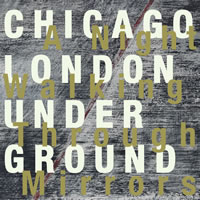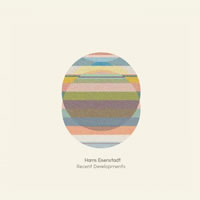Moment's Notice
Reviews of Recent Recordings
(continued)
Gonçalo Almeida + Rodrigo Amado + Marco Franco
The Attic
No Business NBCD 98
 The Attic documents a meeting of three Portuguese improvisers in what may already be the signature Lisbon performance space for free jazz, the Caligari-esque angles of the third floor of SMUP (Sociedade Musical União Paredense), the rehabilitated music society of Parede, a beach-side town a short drive or rail ride along the Tagus River to the Atlantic Ocean where Pedro Costa and the SMUP collective present excellent music, local and imported, with startling frequency.
The Attic documents a meeting of three Portuguese improvisers in what may already be the signature Lisbon performance space for free jazz, the Caligari-esque angles of the third floor of SMUP (Sociedade Musical União Paredense), the rehabilitated music society of Parede, a beach-side town a short drive or rail ride along the Tagus River to the Atlantic Ocean where Pedro Costa and the SMUP collective present excellent music, local and imported, with startling frequency.
The performance brings together three musicians who might define some of the essential qualities of Portuguese free jazz. Gonçalo Almeida may be best known as bassist and composer for Lama, a trio with trumpeter Susana Santos Silva and drummer Greg Smith that has also worked as a quartet with the addition of Chris Speed or Joachim Badenhorst. Rodrigo Amado is a saxophonist of the first rank, increasingly celebrated for both his Motion Trio (both with and without guests Jeb Bishop and Peter Evans) and touring and recording with Joe McPhee, Kent Kessler and Chris Corsano. Drummer Marco Franco is a member of the group Clocks and Clouds and has worked across a broad spectrum of improvised music, from the abstractions of cellist Ernesto Rodrigues to the folk-flavored idiom of guitarist Marcelo dos Reis. Together, Almeida, Amado and Franco may define an essential free jazz: their music is direct, emotionally and structurally focused and absolutely alive to the performance situation and the possibilities of new expressive ground.
The CD opens with Almeida bowing harmonics, suggesting at once the sustained drone of a tambura and the traditional bird imitations of an erhu, creating a combination of meditative calm and creative ambiguity; as Amado and Franco enter, it takes on a stronger modal cast, recalling some of the focused intensity of Pharoah Sanders as Amado’s multiphonics come to suggest a throttled cry. It’s this intensity and directness that come to characterize all the music, moving through the almost-bop, almost-blues, almost-ballad of “Hole” with Almeida and Amado matching upper-registers at the conclusion. There’s an increasingly dense expressionism to “Board.” Following a conversational intro of drums and tenor and a bass solo of bowed harmonics, Amado re-enters with swirling, low-volume harmonics, gradually coming to the fore, building intensity with concentrated repetition of subtly shifting patterns. Almeida digs deeper into his propulsive lower register and Franco, a remarkably fresh drummer, finds new combinations of sounds and rhythms and spaces between. The relatively brief “Nail” is an explosion, the rhythmic tumult firing Amado’s rapid plosives and falsetto wails. What’s most remarkable here is Amado’s ability to control the furies, building tension and form by alternating wails and squeals with precise rhythmic declarations.
Together with the recent Desire & Freedom by Amado’s long-standing Motion Trio (Not Two) with cellist Miguel Mira and drummer Gabriel Ferrandini, The Attic represents a very high level of group interaction and clarity. Eschewing formal compositions, The Attic achieves free jazz with structure and economy that approach Sonny Rollins’ Freedom Suite (Riverside, 1958), just about the most structured and economical music that comes to mind. Amado’s expressive content draws on techniques from Rollins, Sanders and Ayler, among many, but there’s a distinct voice here, characterized in part by a rapid, tight vibrato that further emphasizes the sheer rhythmic invention. This is wholly realized music that deserves to be widely heard.
–Stuart Broomer
Anemone
A Wing Dissolved in Light
NoBusiness Records NBLP 105
 Recorded live at the Tampere Jazz Happening in 2013 by the Finnish Broadcasting Company, A Wing Dissolved in Light presents a whole host of difficulties for the fortunate (or perhaps unfortunate) soul tasked with reviewing it. Two long improvisations with few points of reference, constantly changing sound worlds, moments where matching a sound to its source becomes a guessing game – these and innumerable other qualities reveal the limitations and constraints of the album review genre, to say nothing about the difficulty of turning back a tide of tired clichés. But in this case, that which tortures the reviewer becomes gold for the listener.
Recorded live at the Tampere Jazz Happening in 2013 by the Finnish Broadcasting Company, A Wing Dissolved in Light presents a whole host of difficulties for the fortunate (or perhaps unfortunate) soul tasked with reviewing it. Two long improvisations with few points of reference, constantly changing sound worlds, moments where matching a sound to its source becomes a guessing game – these and innumerable other qualities reveal the limitations and constraints of the album review genre, to say nothing about the difficulty of turning back a tide of tired clichés. But in this case, that which tortures the reviewer becomes gold for the listener.
Anemone (Peter Evans, piccolo trumpet; John Butcher, tenor and soprano; Frédéric Blondy, piano; Clayton Thomas, bass; Paul Lovens, percussion) specializes in that kind of improvisation where getting lost and being ok with that is much of the reward. If the only information I received about this album beforehand was that it featured Morton Subotnik, I would have had no reason to question that after listening to it – such is the ability of Aneone’s members to draw unconventional and surprising sounds from their instruments. It is no stretch to imagine that Evans’ squealing piccolo trumpet could be Suzanne Ciani on a Buchla Box or that Butcher’s flutter tongued soprano isn’t a sample of David Tudor’s “Rainforest.” That each player can mimic each of his bandmates creates more puzzles to decode; it is as if each player is a chameleon who adjusts his sound to either camouflage himself or pop out in a kodachromatic flurry of color. Evans and Butcher – especially when playing together – are particularly adept at this sonic sleight of hand. The continuously shifting context behind whoever happens to be in the foreground further adds to the album’s mercurial nature: skittish hand drumming, running right hand piano lines, scraped bass strings (or is it a bowed cymbal?), bitten reed shrieks, reverberating bass drum bombs, half-choked trumpet growls, and anything else one could imagine flash, mutate, and fade into the ether as suddenly and surprisingly as they first appeared.
Available via download and a limited run of 500 LPs, A Wing Dissolved in Light is one of the most dynamic, mysterious, and intriguing albums of the year.
—Chris Robinson
jaimie branch
Fly or Die
International Anthem Recording Co. IARC 0011
 In 2016 trumpeter jaimie branch assembled an all-Chicago quartet featuring cellist Tomeka Reid, bassist Jason Ajemian, and drummer Chad Taylor. The group came together for a performance in Brooklyn to show New York – as branch puts it – “what Chicago sounds like.” After listening back on that set, branch transcribed several of the freely improvised melodies and ideas and transformed them into the compositions that form the backbone of her debut album, Fly or Die. That’s not all: she incorporated a brass trio with the addition of cornetists Josh Berman and Ben Lamar Gay, asked Matt Schneider to overdub acoustic guitar, and made further edits, loops, and other tweaks (and it’s not clear, but it seems like a dog appears as well). On paper – even with the stellar lineup – the album looks like it could have been an overproduced disappointment. What listeners will find on this crisp, thirty-five minute album is the complete opposite: a captivating and engaging suite that moves listeners from tight grooves to reverb-drenched dreamscapes, from string-fueled maelstroms to stop-time drum solos.
In 2016 trumpeter jaimie branch assembled an all-Chicago quartet featuring cellist Tomeka Reid, bassist Jason Ajemian, and drummer Chad Taylor. The group came together for a performance in Brooklyn to show New York – as branch puts it – “what Chicago sounds like.” After listening back on that set, branch transcribed several of the freely improvised melodies and ideas and transformed them into the compositions that form the backbone of her debut album, Fly or Die. That’s not all: she incorporated a brass trio with the addition of cornetists Josh Berman and Ben Lamar Gay, asked Matt Schneider to overdub acoustic guitar, and made further edits, loops, and other tweaks (and it’s not clear, but it seems like a dog appears as well). On paper – even with the stellar lineup – the album looks like it could have been an overproduced disappointment. What listeners will find on this crisp, thirty-five minute album is the complete opposite: a captivating and engaging suite that moves listeners from tight grooves to reverb-drenched dreamscapes, from string-fueled maelstroms to stop-time drum solos.
While the suite’s individual parts may seem disparate, and to a certain extent they are, their combined sum creates a focused, layered, and multifaceted narrative. The album’s through-line is a lively, gliding, spacious groove that appears in varied iterations on “Theme 001,” “Theme 002,” and “Theme Nothing.” In between listeners encounter a diverse series of episodes, interludes, and segues. As “Theme 001” fades away and unravels Schneider’s light strumming leads a transition into “…meanwhile” that is augmented by Reid and Ajemian’s light pops and plucks. The strings shift into a quasi-drone as Taylor enters and cues “Theme 002.” “Leaves of Glass” is a haunting feature for branch, Berman, and Gay. The eerie call and response between branch and the cornetists gives the effect of some sort of flashback and deviation from the main story. After the appropriately named “The Storm” and “Waltzer” – a non-waltz that showcases branch’s plaintive playing – comes the brief title track, a solo trumpet cut that dives right into “Theme Nothing.” The album concludes with a curious coda that is introduced by a female voice (presumably branch’s) saying “Meanwhile ... back at the ranch.” The piece consists of Schneider’s solo guitar in a somewhat Americana/primitive guitar mode. It’s a bit odd given what came before.
Throughout the album, branch is the main solo voice, and it’s clear that Fly or Die is very much her vision, and perhaps the musical expression of events in her life. It leaves the listener thinking: do I want to listen again right away? Was there something that should be there that isn’t? Does it all hang together? Does it all work? What is the story? What is it about? That the album prompts such questions – some of which may be unanswerable – is a testament to its ability to get into the listener’s mind and draw out a complex reaction, which is the best we can hope of art.
—Chris Robinson
Chicago/London Underground
A Night Walking Through Mirrors
Cuneiform Rune 428
 Even with the very best improvised music, titles can often feel tacked on, an afterthought. But that’s just not true with A Night Walking Through Mirrors, an exceptional new live recording. This isn’t fun house stuff. Here, the mirrors might be more akin to something surreal, out of a Dali or a Miró; or maybe an experiment in science, refractions of shapes and light. It is one of the finest records I’ve heard this year.
Even with the very best improvised music, titles can often feel tacked on, an afterthought. But that’s just not true with A Night Walking Through Mirrors, an exceptional new live recording. This isn’t fun house stuff. Here, the mirrors might be more akin to something surreal, out of a Dali or a Miró; or maybe an experiment in science, refractions of shapes and light. It is one of the finest records I’ve heard this year.
To celebrate their 20th anniversary as the Chicago Underground, Rob Mazurek (cornet, sampler, electronics, voice) and Chad Taylor (drums, mbira, electronics) met up in London’s Cafe Oto. They asked two Englishmen to join them: pianist Alexander Hawkins and bassist John Edwards.
“It really felt like we would be playing and somebody would take a left turn and we’d be in another dimension,” Mazurek recently said. “Another person would take a right turn and we’d be in yet another dimension, but everybody was right there. It really did feel like a night walking through mirrors.”
There are four long improvisations in this bulging, 80-minute set, each containing its own ecosystem. The third, “Boss Redux,” is a piece lifted from Locus (Northern Spy), the 2014 Chicago Underground Duo disc. Taken together, there is an amazing reach – from torrents of discord to a series of sustained experiments in tone and color.
This is one of those marvelous performances that actually translates from stage to disc. Even now, a little more than a year later, the night’s vitality lives on, a treasured first-time meeting. Amazingly, the pairs (Mazurek-Taylor, Hawkins-Edwards) had never played together before.
Drop down anywhere. Zero in on an individual or the collective. A Night Walking Through Mirrors bears this kind of scrutiny: Edwards, by turns earthly, tonally raw, filled with live-wire motion; Hawkins, immediately recognizable now, is, to my mind, one of the great listeners in contemporary music. This must be one of Taylor’s towering performances – all forward motion, building, breaking, galloping and ultimately fueling a terrific, foot-tapping, body-swaying energy. Mazurek’s unerring sense of mood and gesture and sound is here in full: his cornet splinters and shakes, a seeming bystander, then the prime mover, spearheading (I suspect) many of the set’s unshakeable moments, electronically or even in these wild, otherworldly vocals. It is wonderful music.
—Greg Buium
Harris Eisenstadt
Recent Developments
Songlines SGL 1620-2
 Recent Developments is Harris Eisenstadt’s 20th release as a bandleader, and the fifth he has conceived specifically for what used to be called little big bands, following Fight or Flight (Newsonic, 2002), The All Seeing Eye + Octets (Poo-bah, 2006), Woodblock Prints (No Business, 2010), and Canada Day Octet (482 Music, 2012) – albums that use unusual instrumental combinations to explore long-form compositional strategies.
Recent Developments is Harris Eisenstadt’s 20th release as a bandleader, and the fifth he has conceived specifically for what used to be called little big bands, following Fight or Flight (Newsonic, 2002), The All Seeing Eye + Octets (Poo-bah, 2006), Woodblock Prints (No Business, 2010), and Canada Day Octet (482 Music, 2012) – albums that use unusual instrumental combinations to explore long-form compositional strategies.
The nonet featured on Recent Developments includes flutist Anna Weber and bassoonist Sara Schoenbeck alongside the brass trio of trumpeter Nate Wooley, trombonist Jeb Bishop, and tuba player Dan Peck. Supporting the protean frontline is a string-heavy rhythm section, composed of banjo virtuoso Brandon Seabrook, veteran cellist Hank Roberts, and upright bassist Eivind Opsvik, with the leader on drums. The group’s expansive timbral range and chamber music-like scope distinguishes it from Eisenstadt’s smaller combos, like Canada Day and Golden State.
The album’s single work is comprised of six full ensemble parts and eight brief interludes that enable intimate sub-pairings to freely re-interpret the suite’s subtle motivic variations. Eisenstadt claims a diverse array of non-musical influences for this project, including such rich examples of communal creation as author Jane Jacobs’ The Death and Life of Great American Cities, David Chase’s award-winning TV series The Sopranos, and Beni Ourain-style rug weaving of Berbers from Morocco. Musically, Eisenstadt derives inspiration from his elders’ strengths, including Dave Douglas’ lyricism, the rhythmic vitality of Henry Threadgill’s unique instrumental configurations, and the intricacy of John Zorn’s recent work.
Eisenstadt’s contrapuntal themes convey an implied narrative of evolving relationships between individual instruments, balancing re-occurring polyrhythmic vamps with polyphonic interplay and intimate textural explorations. The blend between Schoenbeck and Weber’s woodwinds complements Bishop and Peck’s brassy low-end, with Wooley’s coruscating refrains rising above. The sinewy combination of Roberts and Opsvik’s strings similarly underscores the pointed contributions of Seabrook, whose flinty fretwork imbues the ensemble with its uniquely rustic character. Eisenstadt leads from his drum kit, initiating dynamic changes that spur his bandmates into new avenues for exploration. Despite its generic title, Recent Developments contains some of Eisenstadt’s most animated and engaging compositions to date.
–Troy Collins
